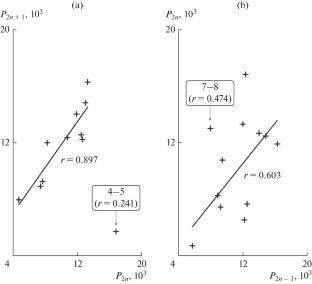Predicting the Maximum of Solar Cycle 25: Total Power at the Cycle’s Beginning and in the Previous Cycle as Precursor
Abstract—
Solar activity, the most famous manifestation of which is sunspots, varies with a period of approximately 11 years. Two 11-year cycles form the 22-year magnetic cycle of the Sun. Changes in solar activity lead to changes in the interplanetary and the near-Earth space and affect the Earth and the human environment. The ability to predict solar activity in advance is important both for some practical tasks of cosmonautics and for a better understanding of the nature of those physical processes at the Sun which are responsible for the solar activity. In the work, the interrelationship of the powers (sum of the monthly sunspot numbers in the cycle) of pairs of “even-numbered to odd-numbered” and “odd-numbered to even-numbered” cycles was investigated, and an attempt was made to forecast the maximum of the current solar cycle 25, which began in December 2019, using the value of the total power of the previous solar cycle 24. It was found that there is a significant correlation between the power and amplitude of the odd-numbered cycle and the power of the previous even-numbered cycle (r = 0.897, p = 0.00043 and r = 0.785, p = 0.00715, respectively; if excluding the pair of cycles four to five). A slightly smaller correlation is observed between the amplitude of the odd-numbered cycle and the amplitude of the previous even-numbered cycle (r = 0.712, p = 0.0209). Regression equations between the relevant parameters were found. The calculated predicted amplitude of solar cycle 25 is 155.6 ± 42.4 for August 2024 or 172.1 ± 46.5 for June 2024 if the power of solar cycle 24 or its maximal amplitude is used as precursor, respectively. For solar cycles 12 to 24, the relationship of the same parameters was investigated separately in the N- and S-hemispheres. It was also found that the southern hemisphere will be slightly more active than the northern one in solar cycle 25; the predicted maximal amplitudes in the N- and S-hemispheres are 86.9 ± 41.1 and 91.7 ± 29.7, respectively. The power of the solar cycle for the first 30 months from its start is closely correlated (r = 0.83, р = 5 × 10–7) both with the amplitude of the next maximum of the cycle and with the duration of the rising phase of the cycle. This makes it possible to obtain, in the authors' opinion, the most probable forecast of the maximum of solar cycle 25 for today, i.e., 136 ± 36 for February 2025. All predictions obtained in this work indicate that solar cycle 25 will be stronger than the previous solar cycle 24.


 求助内容:
求助内容: 应助结果提醒方式:
应助结果提醒方式:


